Early Childhood Education: Emotional/Psychological Development
VerifiedAdded on 2023/01/17
|5
|1030
|56
Report
AI Summary
This report provides an in-depth exploration of emotional and psychological development in early childhood education and care. It details the progression of emotional understanding, expression, and regulation across different age groups, from infancy to the age of 5. The report outlines the various stages of attachment development, including preattachment, attachment-in-the-making, clear-cut attachment, and reciprocal relationships. Additionally, it highlights key developmental milestones related to emotional and psychological growth, such as responding to touch, expressing emotions, imitating behaviors, and developing social skills. The report draws on various academic sources to support its findings, providing a comprehensive overview of the subject matter.
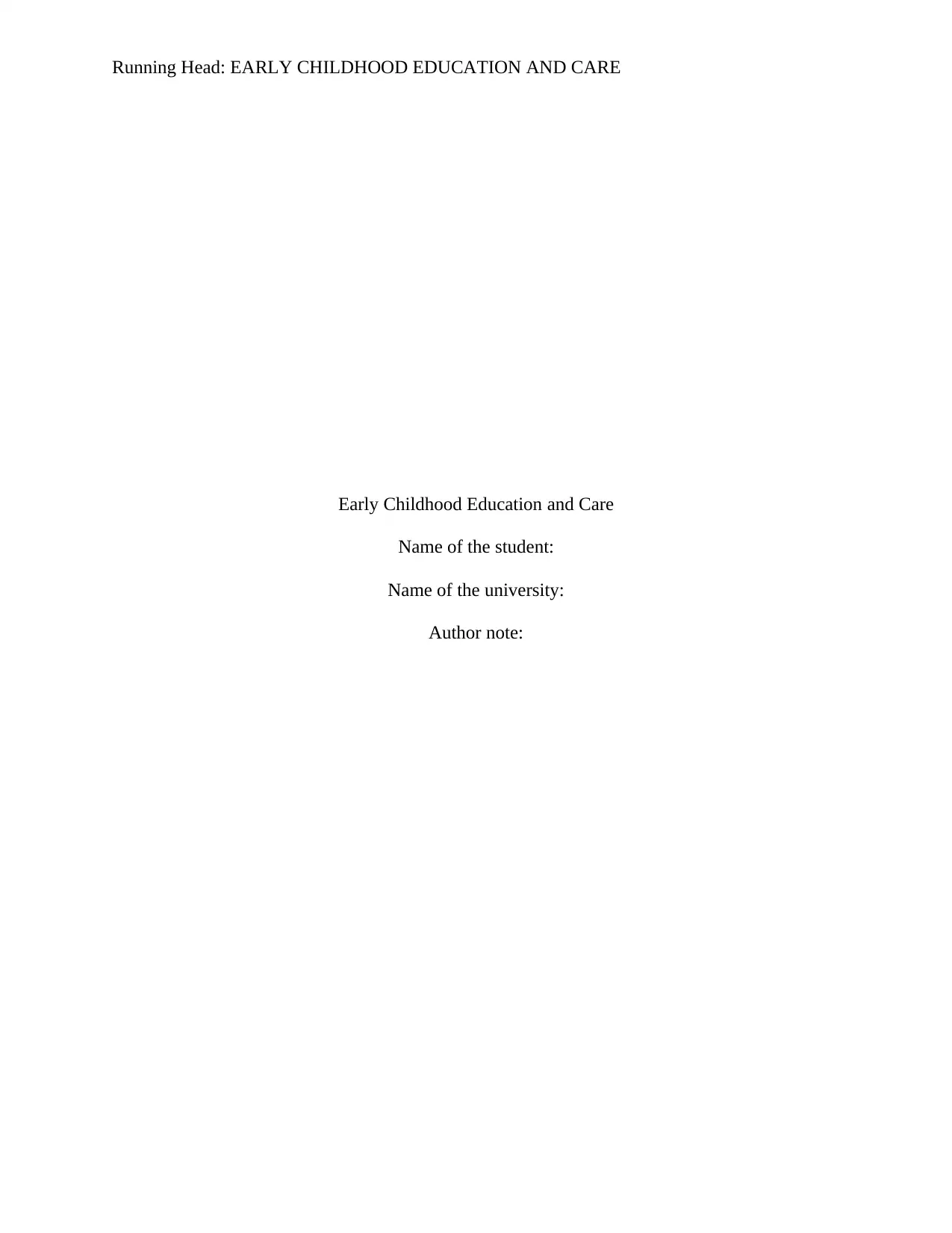
Running Head: EARLY CHILDHOOD EDUCATION AND CARE
Early Childhood Education and Care
Name of the student:
Name of the university:
Author note:
Early Childhood Education and Care
Name of the student:
Name of the university:
Author note:
Paraphrase This Document
Need a fresh take? Get an instant paraphrase of this document with our AI Paraphraser
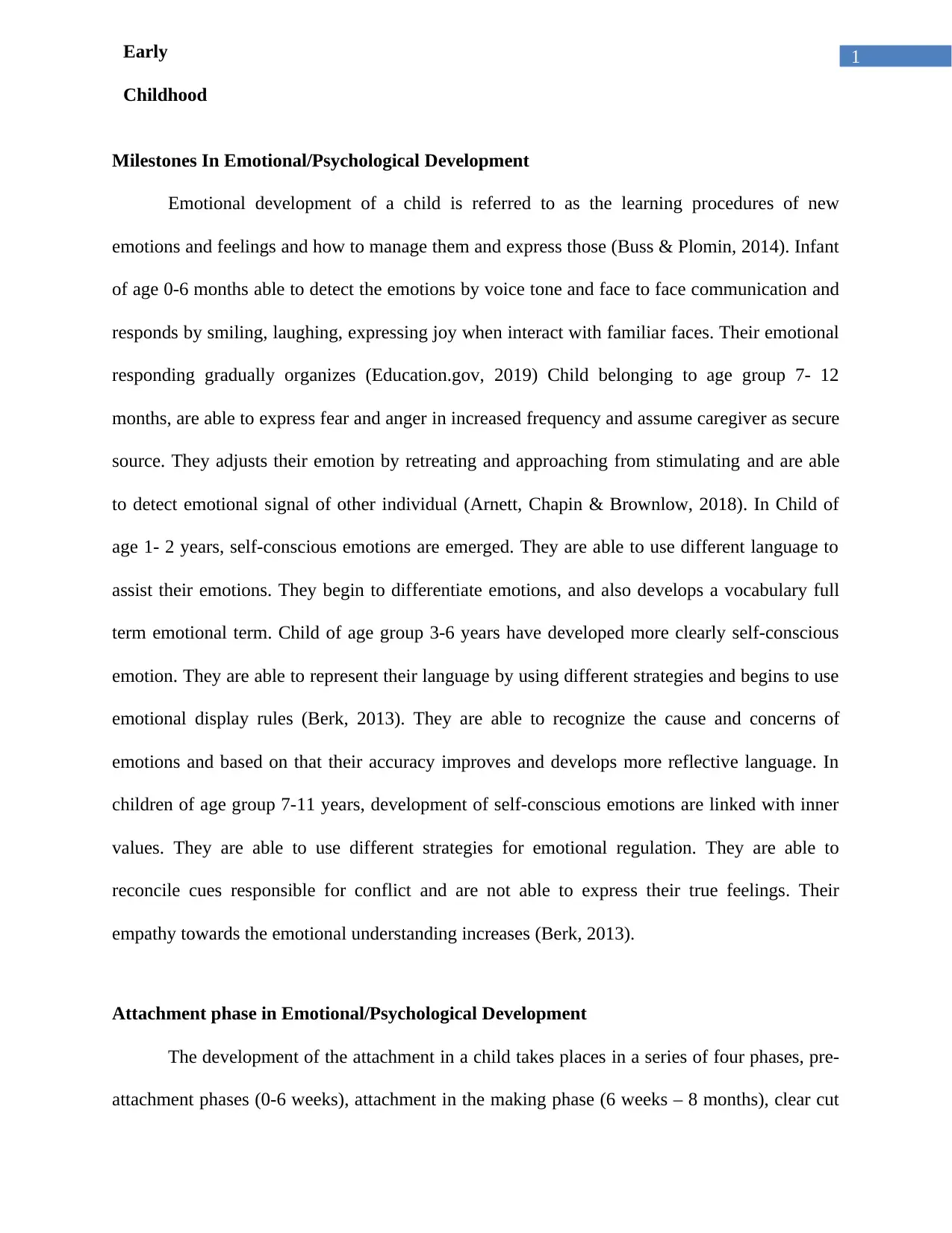
1Early
Childhood
Education and
Milestones In Emotional/Psychological Development
Emotional development of a child is referred to as the learning procedures of new
emotions and feelings and how to manage them and express those (Buss & Plomin, 2014). Infant
of age 0-6 months able to detect the emotions by voice tone and face to face communication and
responds by smiling, laughing, expressing joy when interact with familiar faces. Their emotional
responding gradually organizes (Education.gov, 2019) Child belonging to age group 7- 12
months, are able to express fear and anger in increased frequency and assume caregiver as secure
source. They adjusts their emotion by retreating and approaching from stimulating and are able
to detect emotional signal of other individual (Arnett, Chapin & Brownlow, 2018). In Child of
age 1- 2 years, self-conscious emotions are emerged. They are able to use different language to
assist their emotions. They begin to differentiate emotions, and also develops a vocabulary full
term emotional term. Child of age group 3-6 years have developed more clearly self-conscious
emotion. They are able to represent their language by using different strategies and begins to use
emotional display rules (Berk, 2013). They are able to recognize the cause and concerns of
emotions and based on that their accuracy improves and develops more reflective language. In
children of age group 7-11 years, development of self-conscious emotions are linked with inner
values. They are able to use different strategies for emotional regulation. They are able to
reconcile cues responsible for conflict and are not able to express their true feelings. Their
empathy towards the emotional understanding increases (Berk, 2013).
Attachment phase in Emotional/Psychological Development
The development of the attachment in a child takes places in a series of four phases, pre-
attachment phases (0-6 weeks), attachment in the making phase (6 weeks – 8 months), clear cut
Childhood
Education and
Milestones In Emotional/Psychological Development
Emotional development of a child is referred to as the learning procedures of new
emotions and feelings and how to manage them and express those (Buss & Plomin, 2014). Infant
of age 0-6 months able to detect the emotions by voice tone and face to face communication and
responds by smiling, laughing, expressing joy when interact with familiar faces. Their emotional
responding gradually organizes (Education.gov, 2019) Child belonging to age group 7- 12
months, are able to express fear and anger in increased frequency and assume caregiver as secure
source. They adjusts their emotion by retreating and approaching from stimulating and are able
to detect emotional signal of other individual (Arnett, Chapin & Brownlow, 2018). In Child of
age 1- 2 years, self-conscious emotions are emerged. They are able to use different language to
assist their emotions. They begin to differentiate emotions, and also develops a vocabulary full
term emotional term. Child of age group 3-6 years have developed more clearly self-conscious
emotion. They are able to represent their language by using different strategies and begins to use
emotional display rules (Berk, 2013). They are able to recognize the cause and concerns of
emotions and based on that their accuracy improves and develops more reflective language. In
children of age group 7-11 years, development of self-conscious emotions are linked with inner
values. They are able to use different strategies for emotional regulation. They are able to
reconcile cues responsible for conflict and are not able to express their true feelings. Their
empathy towards the emotional understanding increases (Berk, 2013).
Attachment phase in Emotional/Psychological Development
The development of the attachment in a child takes places in a series of four phases, pre-
attachment phases (0-6 weeks), attachment in the making phase (6 weeks – 8 months), clear cut
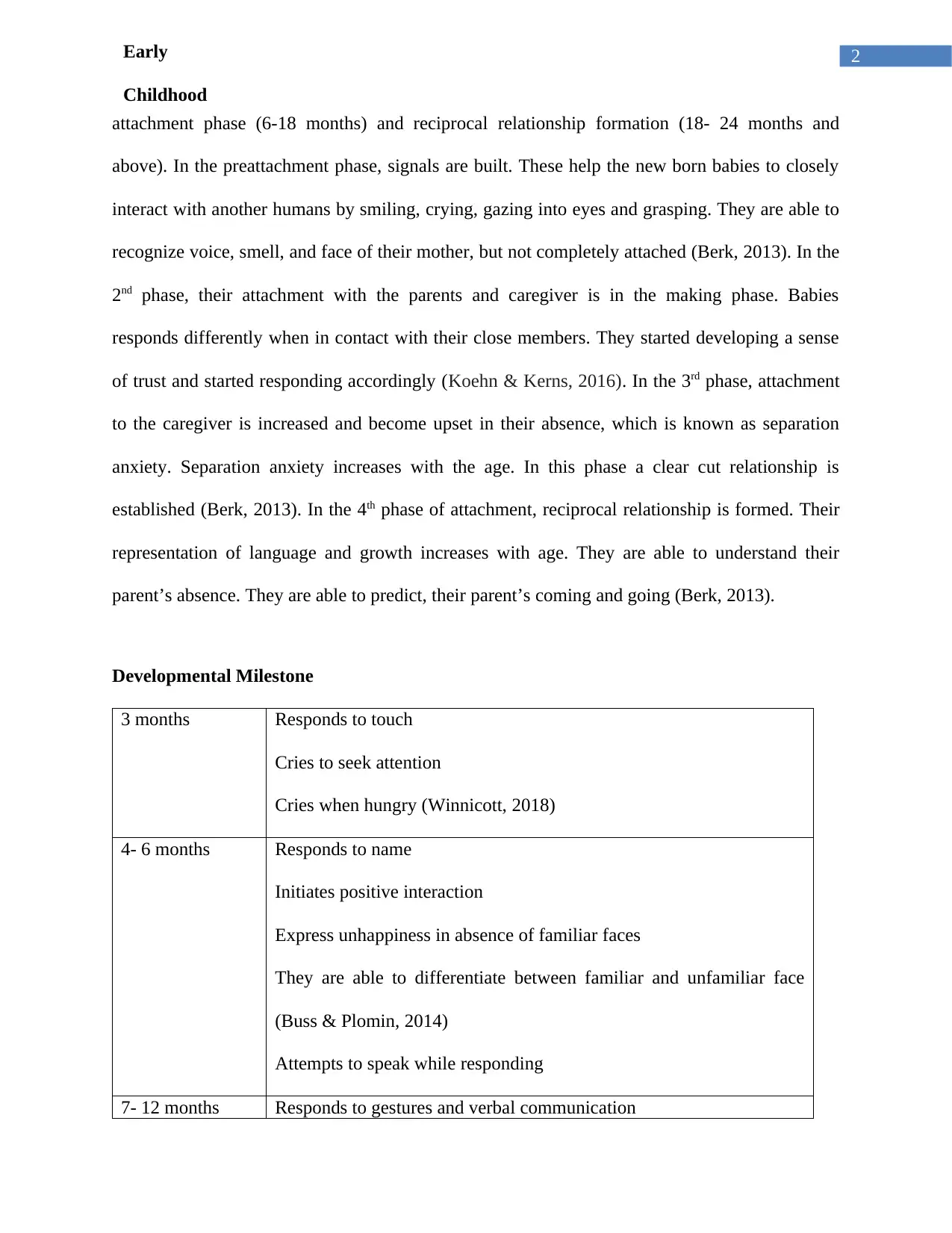
2Early
Childhood
Education and
attachment phase (6-18 months) and reciprocal relationship formation (18- 24 months and
above). In the preattachment phase, signals are built. These help the new born babies to closely
interact with another humans by smiling, crying, gazing into eyes and grasping. They are able to
recognize voice, smell, and face of their mother, but not completely attached (Berk, 2013). In the
2nd phase, their attachment with the parents and caregiver is in the making phase. Babies
responds differently when in contact with their close members. They started developing a sense
of trust and started responding accordingly (Koehn & Kerns, 2016). In the 3rd phase, attachment
to the caregiver is increased and become upset in their absence, which is known as separation
anxiety. Separation anxiety increases with the age. In this phase a clear cut relationship is
established (Berk, 2013). In the 4th phase of attachment, reciprocal relationship is formed. Their
representation of language and growth increases with age. They are able to understand their
parent’s absence. They are able to predict, their parent’s coming and going (Berk, 2013).
Developmental Milestone
3 months Responds to touch
Cries to seek attention
Cries when hungry (Winnicott, 2018)
4- 6 months Responds to name
Initiates positive interaction
Express unhappiness in absence of familiar faces
They are able to differentiate between familiar and unfamiliar face
(Buss & Plomin, 2014)
Attempts to speak while responding
7- 12 months Responds to gestures and verbal communication
Childhood
Education and
attachment phase (6-18 months) and reciprocal relationship formation (18- 24 months and
above). In the preattachment phase, signals are built. These help the new born babies to closely
interact with another humans by smiling, crying, gazing into eyes and grasping. They are able to
recognize voice, smell, and face of their mother, but not completely attached (Berk, 2013). In the
2nd phase, their attachment with the parents and caregiver is in the making phase. Babies
responds differently when in contact with their close members. They started developing a sense
of trust and started responding accordingly (Koehn & Kerns, 2016). In the 3rd phase, attachment
to the caregiver is increased and become upset in their absence, which is known as separation
anxiety. Separation anxiety increases with the age. In this phase a clear cut relationship is
established (Berk, 2013). In the 4th phase of attachment, reciprocal relationship is formed. Their
representation of language and growth increases with age. They are able to understand their
parent’s absence. They are able to predict, their parent’s coming and going (Berk, 2013).
Developmental Milestone
3 months Responds to touch
Cries to seek attention
Cries when hungry (Winnicott, 2018)
4- 6 months Responds to name
Initiates positive interaction
Express unhappiness in absence of familiar faces
They are able to differentiate between familiar and unfamiliar face
(Buss & Plomin, 2014)
Attempts to speak while responding
7- 12 months Responds to gestures and verbal communication
⊘ This is a preview!⊘
Do you want full access?
Subscribe today to unlock all pages.

Trusted by 1+ million students worldwide
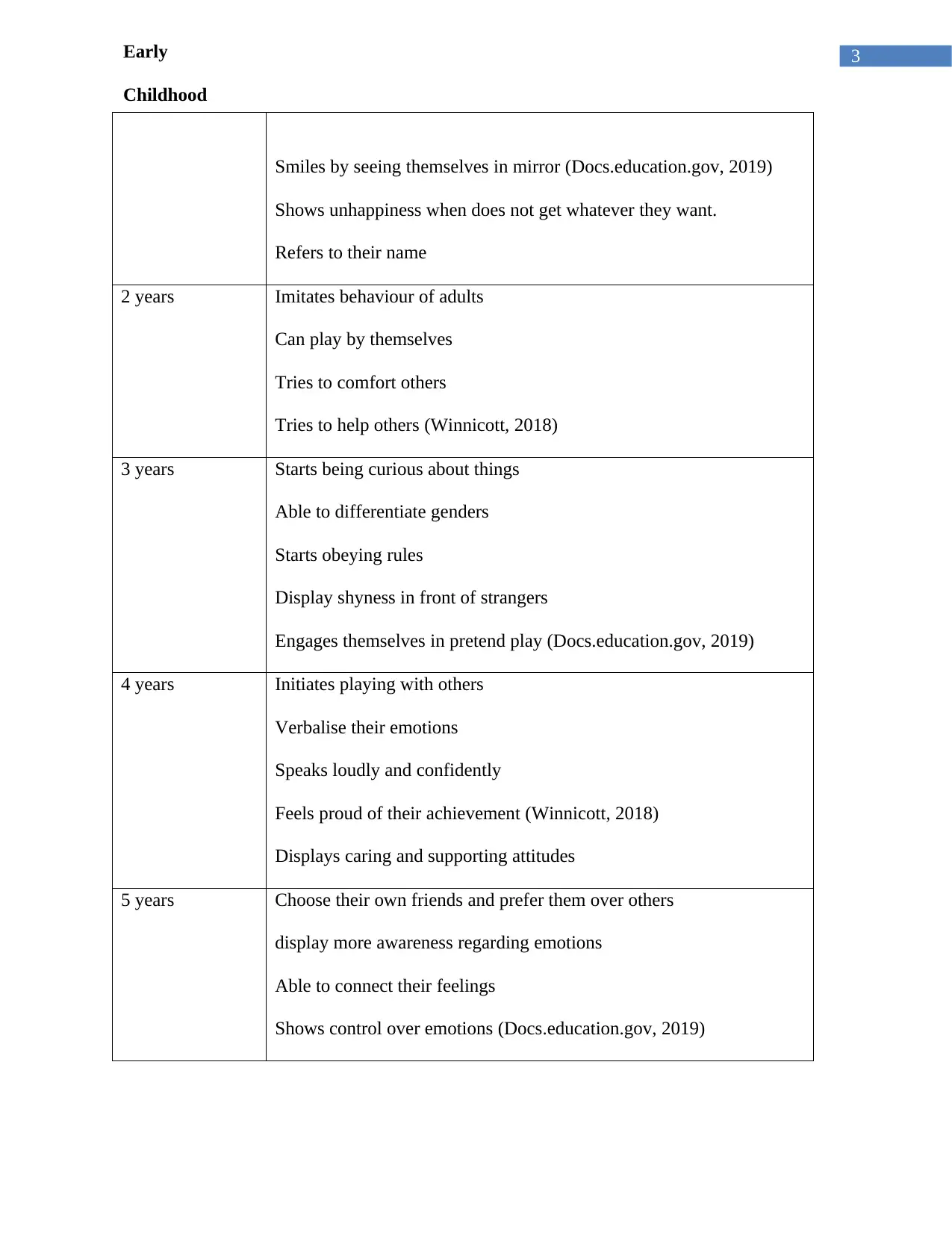
3Early
Childhood
Education and
Smiles by seeing themselves in mirror (Docs.education.gov, 2019)
Shows unhappiness when does not get whatever they want.
Refers to their name
2 years Imitates behaviour of adults
Can play by themselves
Tries to comfort others
Tries to help others (Winnicott, 2018)
3 years Starts being curious about things
Able to differentiate genders
Starts obeying rules
Display shyness in front of strangers
Engages themselves in pretend play (Docs.education.gov, 2019)
4 years Initiates playing with others
Verbalise their emotions
Speaks loudly and confidently
Feels proud of their achievement (Winnicott, 2018)
Displays caring and supporting attitudes
5 years Choose their own friends and prefer them over others
display more awareness regarding emotions
Able to connect their feelings
Shows control over emotions (Docs.education.gov, 2019)
Childhood
Education and
Smiles by seeing themselves in mirror (Docs.education.gov, 2019)
Shows unhappiness when does not get whatever they want.
Refers to their name
2 years Imitates behaviour of adults
Can play by themselves
Tries to comfort others
Tries to help others (Winnicott, 2018)
3 years Starts being curious about things
Able to differentiate genders
Starts obeying rules
Display shyness in front of strangers
Engages themselves in pretend play (Docs.education.gov, 2019)
4 years Initiates playing with others
Verbalise their emotions
Speaks loudly and confidently
Feels proud of their achievement (Winnicott, 2018)
Displays caring and supporting attitudes
5 years Choose their own friends and prefer them over others
display more awareness regarding emotions
Able to connect their feelings
Shows control over emotions (Docs.education.gov, 2019)
Paraphrase This Document
Need a fresh take? Get an instant paraphrase of this document with our AI Paraphraser
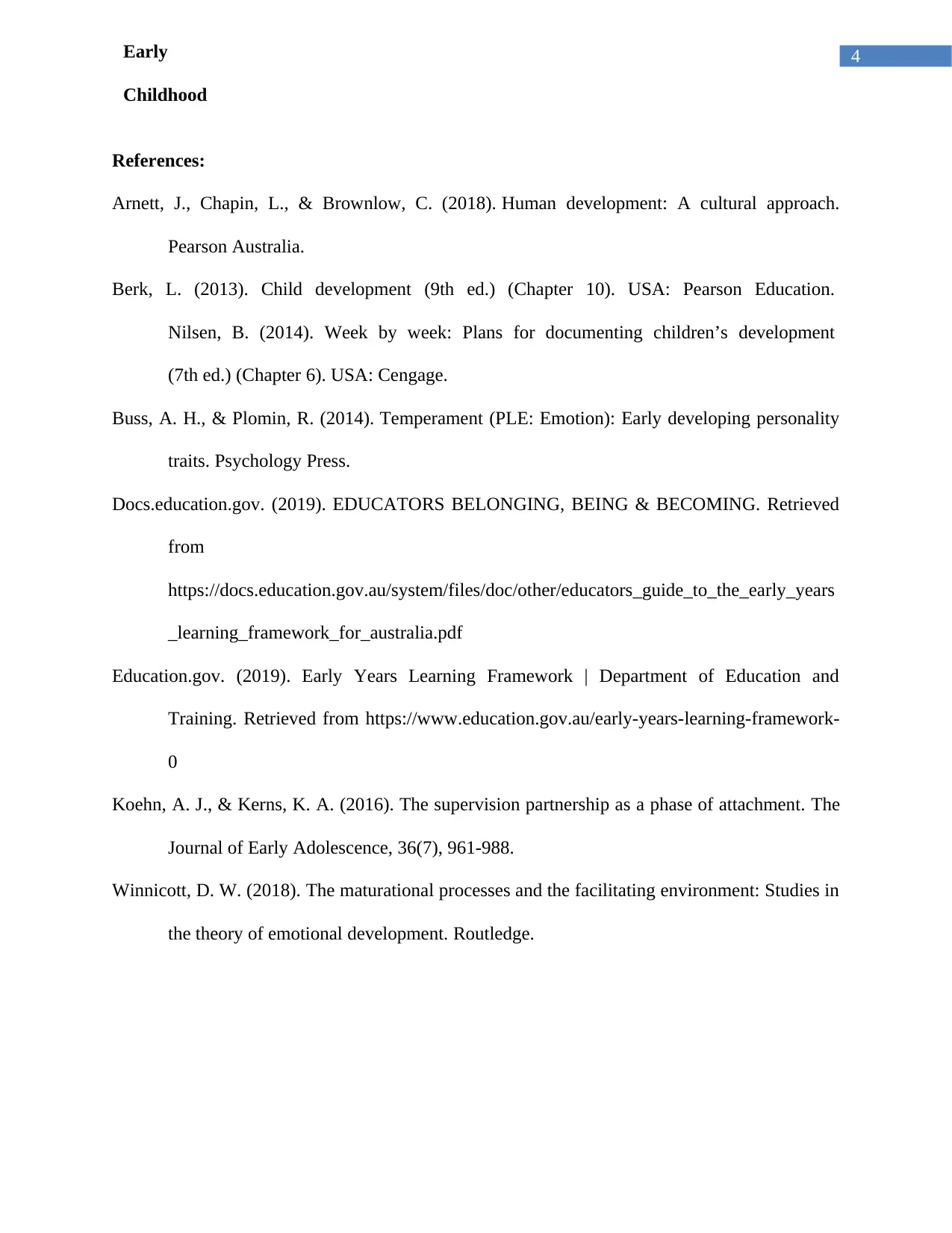
4Early
Childhood
Education and
References:
Arnett, J., Chapin, L., & Brownlow, C. (2018). Human development: A cultural approach.
Pearson Australia.
Berk, L. (2013). Child development (9th ed.) (Chapter 10). USA: Pearson Education.
Nilsen, B. (2014). Week by week: Plans for documenting children’s development
(7th ed.) (Chapter 6). USA: Cengage.
Buss, A. H., & Plomin, R. (2014). Temperament (PLE: Emotion): Early developing personality
traits. Psychology Press.
Docs.education.gov. (2019). EDUCATORS BELONGING, BEING & BECOMING. Retrieved
from
https://docs.education.gov.au/system/files/doc/other/educators_guide_to_the_early_years
_learning_framework_for_australia.pdf
Education.gov. (2019). Early Years Learning Framework | Department of Education and
Training. Retrieved from https://www.education.gov.au/early-years-learning-framework-
0
Koehn, A. J., & Kerns, K. A. (2016). The supervision partnership as a phase of attachment. The
Journal of Early Adolescence, 36(7), 961-988.
Winnicott, D. W. (2018). The maturational processes and the facilitating environment: Studies in
the theory of emotional development. Routledge.
Childhood
Education and
References:
Arnett, J., Chapin, L., & Brownlow, C. (2018). Human development: A cultural approach.
Pearson Australia.
Berk, L. (2013). Child development (9th ed.) (Chapter 10). USA: Pearson Education.
Nilsen, B. (2014). Week by week: Plans for documenting children’s development
(7th ed.) (Chapter 6). USA: Cengage.
Buss, A. H., & Plomin, R. (2014). Temperament (PLE: Emotion): Early developing personality
traits. Psychology Press.
Docs.education.gov. (2019). EDUCATORS BELONGING, BEING & BECOMING. Retrieved
from
https://docs.education.gov.au/system/files/doc/other/educators_guide_to_the_early_years
_learning_framework_for_australia.pdf
Education.gov. (2019). Early Years Learning Framework | Department of Education and
Training. Retrieved from https://www.education.gov.au/early-years-learning-framework-
0
Koehn, A. J., & Kerns, K. A. (2016). The supervision partnership as a phase of attachment. The
Journal of Early Adolescence, 36(7), 961-988.
Winnicott, D. W. (2018). The maturational processes and the facilitating environment: Studies in
the theory of emotional development. Routledge.
1 out of 5
Related Documents
Your All-in-One AI-Powered Toolkit for Academic Success.
+13062052269
info@desklib.com
Available 24*7 on WhatsApp / Email
![[object Object]](/_next/static/media/star-bottom.7253800d.svg)
Unlock your academic potential
Copyright © 2020–2025 A2Z Services. All Rights Reserved. Developed and managed by ZUCOL.





